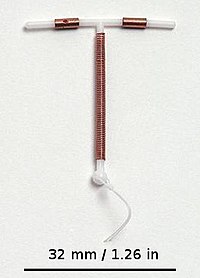
Photo from wikipedia
Abstract Objective The study aims to investigate the effect of slow versus fast vulsellum application on the cervix on the perceived pain during copper intrauterine device (IUD) insertion. Study design… Click to show full abstract
Abstract Objective The study aims to investigate the effect of slow versus fast vulsellum application on the cervix on the perceived pain during copper intrauterine device (IUD) insertion. Study design We conducted a randomized controlled trial at a tertiary university hospital from October 2016 to May 2017 included women desiring copper IUD insertion. We randomized the participants in a 1:1 ratio to slow and fast vulsellum application during IUD insertion. The primary outcome measure was the subjects’ self-reported pain using a 100 mm Visual Analogue Scale (VAS) during cervical tenaculum placement. We considered a 20 mm difference in VAS scores as clinically significant. The secondary outcomes included the difference in pain scores during IUD insertion and five minutes after insertion, the amount and duration of vulsellum site bleeding. Results The study included 200 women (n = 100 in each group). Women in the slow vulsellum group had significant lower pain scores during tenaculum placement, IUD insertion and 5 min post-insertion (p = .0001). However, the difference in pain scores did not show a clinical significance. The duration needed to control the bleeding in fast vulsellum group was 2.34 min versus 1.87 min in the slow vulsellum group (p = .006). Additionally, the VAS score for the amount of bleeding was significantly higher in the fast than the slow vulsellum group (2.83 ± 1.38 vs. 1.97 ± 1.45. p = .008). Conclusions Slow vulsellum application could reduce the pain scores during IUD insertion as compared with fast vulsellum application. Moreover, it is associated with less amount and duration of bleeding from the vulsellum puncture sites.
Journal Title: Middle East Fertility Society Journal
Year Published: 2018
Link to full text (if available)
Share on Social Media: Sign Up to like & get
recommendations!